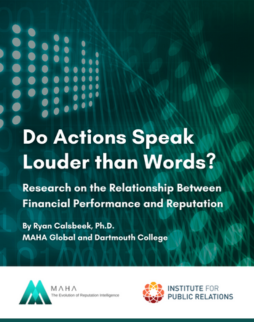 The second semester of my MBA experience at SMU’s Cox School of Business included marketing, decision modeling, cost accounting, microeconomics, and, well, a big dose of quantitative envy. Good thing I enjoy crunching numbers, but all this analysis underscored for me some challenges – and opportunities – we have as corporate communicators.
The second semester of my MBA experience at SMU’s Cox School of Business included marketing, decision modeling, cost accounting, microeconomics, and, well, a big dose of quantitative envy. Good thing I enjoy crunching numbers, but all this analysis underscored for me some challenges – and opportunities – we have as corporate communicators.
We’re not alone in our quest for a seat at the decision-making table. Marketing fights for their position too, with the average tenure of a CMO being a short 3-5 years because of either burnout or an inability to produce sufficient results. I’m impressed by marketing’s ability to quantify customer value via combinations of price and quality measures, place a dollar figure on the expected lifetime value of a customer relationship, and project market share of a new or improved product line, among other numerical feats straightforward enough to handle with a simple calculator. Trust me; I did so repeatedly. And each time, I felt a twinge of measurement envy. The grass sure looks greener on the marketing side.
My other classes didn’t provide any solace. As a member of my high performing study group often laments, “It’s all math,” and he’s right. The business disciplines literally run on numbers. Bring your numbers to the table, or be ignored. Two frequently repeated mantras shared by professors with extensive industry experience reminded me of this fact throughout my first spring semester:
- First, when faced with two alternatives, the only information relevant to decision-making is a quantifiable difference in cost or benefit. Nothing else matters. Nothing.
- And, second, CEO reputations are more frequently made on cost cutting, not brand building.
These edicts won’t surprise anyone with corporate experience, but they serve as good reminders of how our contributions are judged in the C-suite. So, instead of sulking about who has better measurement sticks, I am now inspired to ponder how we can apply similar thinking to public relations practice. Here are a few starting points:
- How can we better incorporate revealed preferences in our research methodologies? Economists and marketers alike swear by the predictive power of consumer preferences revealed via observable behavior rather than by just completing yet another survey. Give respondents some skin in the game (e.g., money to spend or a vote to cast in a test setting), and their behavior speaks volumes. Expensive? Complicated? Perhaps. But the concept of revealed preferences warrants additional thinking about behavior-based research in our field.
- All marketing eyes are on the customer (and their definition of “customer” is broad), but what about those numerous other stakeholders we care about? How can we quantify concepts of price, quality, value, and benefits for employees, communities, investors, and suppliers? Remember, the advocate must quantify and demonstrate a differential cost or benefit to be relevant to executive decision-making.
- Accountants refer to goodwill as the amount paid for a company over and above the market value of its net assets. Goodwill is an intangible asset but one clearly tied to the perceived value of a firm and the quality of its stakeholder relationships. It’s on the company’s balance sheet and can increase or decrease in value over time. Quantifying goodwill in light of public relations efforts seems to me a fruitful area for further exploration.
- Linear programming and Monte Carlo simulations were real eye-openers for me this semester. The former is an optimization method that literally provides a recipe on how best to allocate resources by minimizing cost or maximizing profit, and the latter provides random iterations of “what if” scenarios for decision-making. Both are readily done on Excel. As with any statistical modeling, the quality of the output depends on the quality of parameters provided, but, wow, these are impressive tools we should be using in our own investigations of media spending, crisis management, and other areas.
- And, finally, we talk a lot about reputation enhancement, but how are we likewise saving (and even making) money through effective cultivation and stewardship of stakeholder relationships? There’s a quantifiable benefit to avoiding a lawsuit through negotiation, improving a product with active listening, and retaining quality suppliers and employees. How can we credibly track our contributions in these areas – and effectively present them to the cost-minded CEO?
At this juncture, I have more questions than answers. But, I’m a true believer in the broader societal benefits of the work we do, and I’m enthused and challenged by my MBA journey. I entered public relations from the finance side and quickly realized how much influence, responsibility, and fulfillment I have as a communicator. I like our side of the fence, so I’ll keep tinkering and sharing ways to apply these quantitative tools to public relations. If you’re already dabbling in these areas, let’s talk. In the comforting words of my renowned marketing professor, “Partial credit is a gift from God.” Quantifying the value we create for companies is a worthwhile and critical, if not yet perfected, endeavor.
Sandy Duhé is associate professor, head of public relations, and chair of the Division of Communication Studies at Southern Methodist University. She is a member of the PRSA College of Fellows and the Arthur W. Page Society.




Thanks much, Angie. I’m excited about building on what I’ve learned!
Sandy, what a marvelous article. I envy you the chance to get your MBA, but not all the math! But you are right – in the business world today, if you can’t bring it with the numbers, you’ll have no seat at any table. Congratulations on your great adventure.